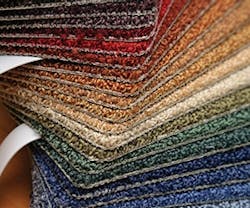Specifying carpet with recycled content is beneficial to the environment, corporate responsiblity and green certification programs. It’s the right thing to do, but knowing how to make the best choice is daunting. To ensure your choice is truly sustainable, take the time to find out what’s in your carpet selection, how it was manufactured, and where it will end up when you’re finished with it.
The Impact of Recycled Content
“Recycled content can be incorporated into many parts of carpet,” says Philip Ivey, Sustainability Leader of the Global Floor Covering Division with Milliken. He notes that both pre- and post-consumer recycled content are frequently used in carpets, including recycled mineral fillers like ash, glass powder, or rock powder.
But content isn’t the only aspect that should be sustainable. According to Mikhail Davis, Director of Restorative Enterprise at Interface, “reclaimed materials do not change the environmental impact of producing carpet as much as replacing virgin plastic with recycled plastic.” Nylon 6 or 6,6 requires an incredible amount of energy, water, and chemicals – almost five times the energy used to produce other common plastics, he explains. “If your nylon carpet fiber has lots of recycled content but none of it is in the nylon face fiber, the recycled content isn’t as environmentally meaningful,” Davis says.
It is also important to consider that dangerous chemicals may still be present when you recycle carpet. Rochelle Routman, Vice President of Sustainability at Mohawk, cites the Living Building Challenge’s Red List chemicals, which include formaldehyde, lead, BPA, phthalates, and PVC.
Earn LEED Credits with Sustainable Carpet
Recycled carpet content can earn multiple LEED credits, notes Philip Ivey, Sustainability Leader, Global Floor Covering Division for Milliken.
- Flooring with recycled content can be submitted for Materials Credit 4 – Recycled Content.
- You can gain another point by diverting used carpet from entering landfills with Materials Credit 2 – Construction Waste Management.
- Carpet with few or no VOCs qualifies under Materials Credit 4.1 – Low Emitting Materials.
“If you have old carpet containing these harmful substances and you recycle it into new flooring, the original chemicals don’t necessarily disappear,” Routman explains. She adds that, unlike 10 years ago when companies would take anything they could find to boost their percentage of recycled content, the bigger picture is now being considered, including residual chemicals.
In addition to reducing overall resource consumption, carpets with a strong sustainability profile can strengthen your bottom line. Experts agree that recycled content has no negative impact on performance or longevity. With new technologies reducing the frequency with which carpet needs to be replaced, making a green selection can have a profound impact on a product that can be in place for decades.
Carpet containing repurposed materials can also garner points in certification programs. Davis points out that a growing number of certification systems are starting to acknowledge the entire impact of building products rather than a single attribute: “The shift in certification systems from emphasizing recycled content to asking for full disclosure with an environmental product declaration shows how this understanding is evolving.”
Ask the Right Questions
So which attribute should you focus on? As Ivey says, “There is not one specific feature that makes a product more sustainable than another. It’s the combination of the overall efforts to manufacture the product and design it with its end-of-life in mind.”
He recommends third-party verifications like EPDs by UL and standards such as ISO 9001 and NSF 140 to navigate through supplier claims and hold manufacturers accountable. Routman echoes the importance of third-party certification and encourages facility managers to “work with suppliers who share information openly.”
Davis offers these key questions to ask your carpet supplier:
1. Where did this product come from? Does its manufacturing process keep materials out of the landfill or ocean?
2. Is it safe to use in its new application based on the additives it still has from its last life?
3. Did using recycled content substantially reduce the environmental impact of producing this product?
4. Can this item be recycled again?
“With the number of new transparency tools, product declarations, and building certifications, it’s easy to become overwhelmed trying to discern what makes a product truly sustainable,” says Ivey. Use information from neutral sources you can trust such as the Carpet and Rug Institute (CRI), Carpet America Recovery Effort (CARE), and the EPA.
Being an advocate for the environment and your own sustainability standards will get you on the right (carpeted) path.
Jenna M. Aker is a Contributing Editor for BUILDINGS.
